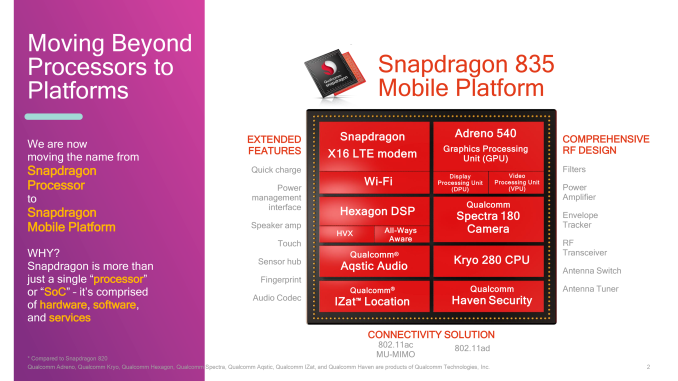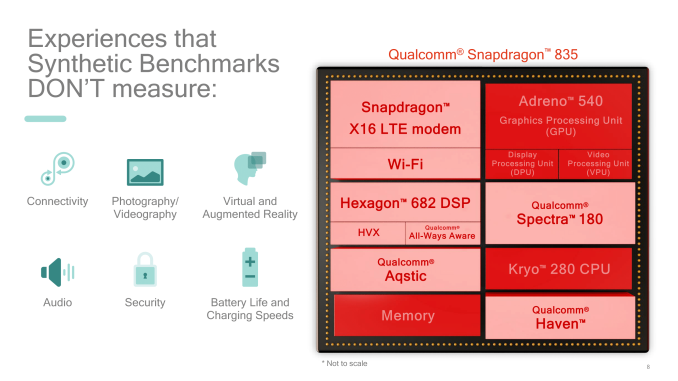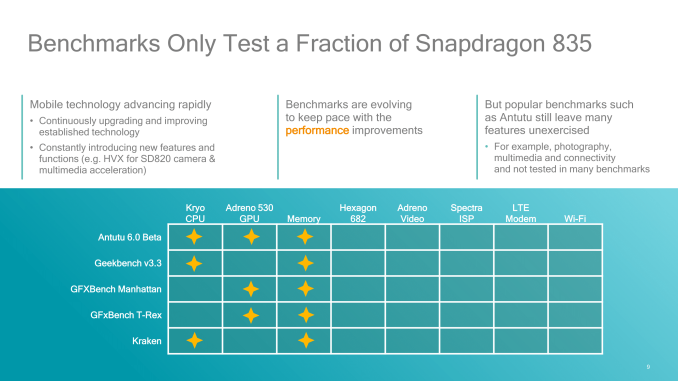The Qualcomm Snapdragon 835 Performance Preview
by Matt Humrick & Ryan Smith on March 22, 2017 4:30 AM EST- Posted in
- Smartphones
- Snapdragon
- Qualcomm
- Mobile
- SoCs
- Snapdragon 835
- Kryo
Qualcomm's Thoughts on Benchmarks versus End-User Experiences
While the primary purpose of our visit out to Qualcomm’s offices was for benchmarking, for this year’s event Qualcomm went one step further and invited us to take a tour of some of their labs. The tour itself was plenty interesting (more on this in a bit), however arguably the more important aspect of the tour isn’t what we saw, but why Qualcomm is giving the press lab tours after so long. A tour may sound trite, but for Qualcomm it’s a sign of bigger things.
Perhaps the most important thing to understand about Qualcomm is that while the bulk of the company’s revenue comes from chips, the majority of their actual profits come from various technology and patent licensing programs. The actual breakdown between the two halves of Qualcomm gets a bit weird when trying to best account for which half foots the bill for R&D, but at the end of the day it’s Qualcomm’s licensing business that is making them the most money.
| Qualcomm Financials (FY'2016) | ||||
| Chip-Making | Licensing | |||
| Revenue | $15.4B | $7.6B | ||
| Profit (Pretax) | $1.8B | $6.5B | ||
As a result, if boardroom-level rumors are to be believed, the company is never quite sure how to balance the two businesses. Some groups want licensing and chip design separated, and others want them to stay combined. Qualcomm seems content to stick with the status quo and their $5.7B in profits for 2016, but as a consequence of this unusual split it means that the chip side of Qualcomm is always under a bit of pressure to prove itself.
The good news for the chip business is that it’s doing fairly well, especially in North America. Most high-end Android smartphones sold in the US are based on Qualcomm’s chips, Qualcomm’s modems are in some (but no longer all) of Apple’s iPhone SKUs, and even in the midrange market Qualcomm’s Snapdragon 600 series chips are in a number of popular phones. The flip side of this is that outside of the US and especially outside of the high-end, Qualcomm’s chip business is under constant pressure from both their partners and their competitors. Samsung is happy to stick with their own home-grown Exynos chips outside of North America, and other chip vendors like MediaTek nip at Qualcomm’s heels with competent midrange SoCs that are priced very aggressively. So while Qualcomm’s chip business is doing well right now, that could very well change in the future.
But what does this have to do with a press tour of their labs? One of the big initiatives for Qualcomm, as exemplified in last week’s Snapdragon branding tweak, is that the chip arm of the company wants to get away from being so frequently judged on the basis of their CPU and only their CPU. This is why Snapdragon is now a platform versus a processor, and similarly, it’s why we’re going to see Qualcomm increasingly talking up the other aspects of their SoCs in the future. Their SoCs and associated front-end hardware are more than just the Kryo CPU, and they want the world to know that.
For Qualcomm this move makes a lot of sense. CPU performance is still growing year-after-year, but as we’ve seen, those gains are plateauing some as a consequence of diminishing IPC gains and diminishing clockspeed gains. Meanwhile, although the Kryo is a customized CPU design, as we’ve seen in our benchmark data it doesn’t behave radically different from ARM’s Cortex-A72 and Cortex-A73 designs that other vendors can license. Short of a “Cyclone” moment for Qualcomm, their CPU performance is close enough to the rest of the Android pack that they can’t clearly stand out from other vendors in the way Apple can. And that means they need to promote and sell their SoCs as the sum of their parts, and not just a CPU with a bunch of extra stuff bolted on.
This also means that even though Qualcomm is one of the first vendors to ship a 10nm high-end SoC – and enjoying the performance benefits thereof – we’re also going to see the company downplay benchmarks a bit for not capturing the complete “end-user experience.”
And to the company’s credit, they aren’t wrong. CPU, GPU, and memory performance are all easy enough to test, vary a great deal among SoC designs, and are similarly easy to communicate. DSPs, ISPs, and other aspects are not nearly as easy to test, never mind communicating those advantages to a wider audience.
Still, once we get outside of CPU/GPU/memory and into other functional blocks of a SoC, things get murkier for everyone. A video decode block may as well be a static piece of hardware – as long as it does its job well, no one will notice – and a great Wi-Fi radio can be kneecapped by a bad device design. So as much as Qualcomm wants to push the broader end-user experience, they will never completely escape the fact that the core features of their SoCs will be the first to be put to the test, and that wider testing is going to be less meaningful to customers, or more practically speaking outside the budgets of technology journalists.













128 Comments
View All Comments
yankeeDDL - Wednesday, March 22, 2017 - link
In most of the graphs where the iPhone is present, they trounce anything else. It is quite disappointing, being an Android enthusiast, to see that the 835 does not catch up with a 6 month old phone...shing3232 - Wednesday, March 22, 2017 - link
but the bright side is that huge reduction in Power usage compare to 820ddriver - Wednesday, March 22, 2017 - link
This is comparing apples to oranges. Unless the two CPUs run the same code, performance is irrelevant.The web is majorly a shitpile of bloat, ridden with inefficiency. Apple simply invested more time into optimizing their web / JS implementation. This is not really indicative of CPU performance, only of web implementation optimizations.
And while it is true that apple's single threaded performance has been better, that is only a part of the story. You have the budget of n amount of transistors to put into x amount of total performance. If you have more threads, then obviously individual threads will be slower. Optimizing for low count threads is actually a pretty good idea given the typical mobile device usage patterns.
Why do most ARM chipmakers push for higher core count is a mystery to me. That is a STUPID strategy. It makes it that much harder to squeeze the most of your hardware.
I've been running proprietary software on phones and tables since 2012, software designed to scale adequately, and as a result, I see better overall performance from flagship android devices despite apple's better ST performance, but only because of the kind of workloads I am running. So while the chips aren't anywhere nearly as slow as AT's lame benchmarking suite would suggest, it is not exactly straightforward to get the max of their performance.
Lastly, the is this thing called "fast enough". Even if apple chips are traditionally faster in typical mobile applications than those found in android devices, this is not really an issue if the slower devices are still fast enough. I haven't really seen bottlenecks in the few 3rd party android apps I am using, so even with software that has not been designed to make use of many cores, things still run fast enough to not present an issue in regards with user experience.
All in all, in general I'd say ARM is not really trying to make things good, at least not as far as the user is concerned. The only reason apple invest into tangibly improving on the stock ARM designs is for the hype factor, rather than actually putting that performance into productivity. Mobile platforms are doubly limited just to make sure they don't revolutionize computing, both in terms of hardware, and available software. Pretty much next to useless toys, intended to use you far more than you use them, unless you have the resources to put into developing proprietary software tailored to your productivity needs.
close - Thursday, March 23, 2017 - link
Apple has yet another advantage. Since it controls its ecosystem end to end it can optimize the software for their specific hardware. In the Android ecosystem you have configurations ranging from 1 to 10 cores (or more?), so many different generations, so many different custom and semi-custom cores. A little trickier to optimize. So Android OEMs go for the numbers. Core numbers that is. Now with 25% more cores.And lets not forget another aspect. Historically Apple focused on optimizing the SoC layout for performance which led to much bigger cores which doesn't seem to be the method of choice in the Android ecosystem. They worked on improving the density, especially with the A8 and the A10.
ericgl21 - Wednesday, March 22, 2017 - link
Yep...iPhone's A10 Fusion chip is very capable indeed. And in September they're probably going to announce a better one (maybe called "A11"). Looks like Apple is ahead of everyone else, especially when it comes to web-related speeds.Samip - Wednesday, March 22, 2017 - link
Did you not read the disclaimer right below the web benchmarks?joms_us - Wednesday, March 22, 2017 - link
Guess what? I have never seen any comparison between iPhone 7 and flagship Android phone with SD821 where iPhone 7 is faster in app and browsing site. These benchmarks mean nothing if you are using different platforms particularly OS.Check out this comparison
https://youtu.be/mcTAXsFHu5I
gigathlete - Wednesday, March 22, 2017 - link
Check out this comparison: https://www.youtube.com/watch?v=vm8zC2VAr8wjoms_us - Wednesday, March 22, 2017 - link
Bwaha PhoneBluff. Who launches 10 apps in a minute and close it right away with the home button? Retards?His finger is faster on the home button of iPhone than OP3T =D
TadzioPazur - Wednesday, March 22, 2017 - link
This "test" is broken. Instead of measuring each activity individually, the test mashes them all together and measures total time. This makes no sense whatsoever - users are interested in doing one thing at a time, so individual tests somehow reflect perceived speed of the device.Measuring all together is not how we use these kind of devices. Especially that a lot of those activities reflect the mass storage sequential read. So all PhoneBuff needed to have done to show his beloved device was the fastest, was to put enough application load activities and leverage faster IO.
So I do think this "test" is so much worse than the above, posted by @joms_us.